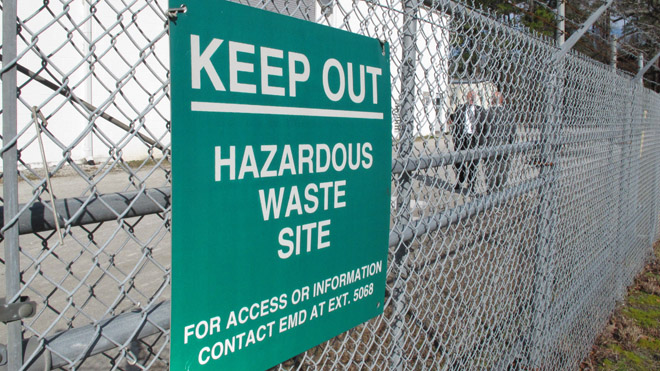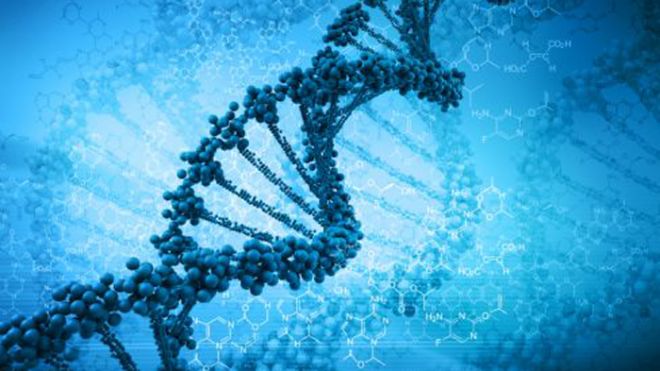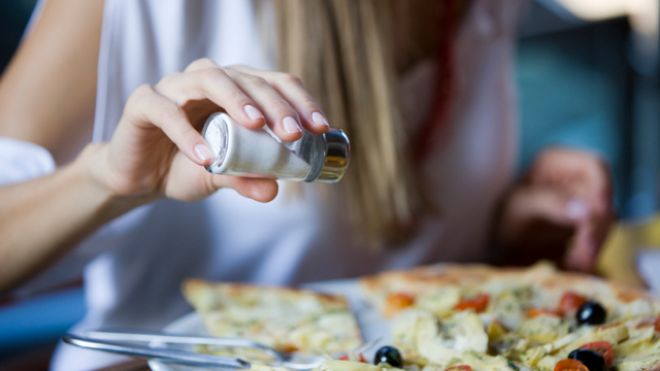
CAMP LEJEUNE, N.C. – & A simple test could have alerted officials that the drinking water at Camp Lejeune was contaminated, long before authorities determined that as many as a million Marines and their families were exposed to a witch's brew of cancer-causing chemicals. But no one responsible for the lab at the base can recall that the procedure -- mandated by the Navy -- was ever conducted. The U.S. Marine Corps maintains that the carbon chloroform extract (CCE) test would not have uncovered the carcinogens that fouled the southeastern North Carolina base's water system from at least the mid-1950s until wells were capped in the mid-1980s. But experts say even this “relatively primitive” test -- required by Navy health directives as early as 1963 -- would have told officials that something was terribly wrong beneath Lejeune's sandy soil. A just-released study from the federal Agency for Toxic Substances and Disease Registry cited a February 1985 level for trichloroethylene of 18,900 parts per billion in one Lejeune drinking water well -- nearly 4,000 times today's maximum allowed limit of 5 ppb. Given those kinds of numbers, environmental engineer Marco Kaltofen said even a testing method as inadequate as CCE should have raised some red flags with a “careful analyst.” “That's knock-your-socks-off level -- even back then,” said Kaltofen, who worked on the infamous Love Canal case in upstate New York, where drums of buried chemical waste leaked toxins into a local water system. “You could have smelled it.” Biochemist Michael Hargett agrees that CCE, while imperfect, would have been enough to prompt more specific testing in what is now recognized as the worst documented case of drinking-water contamination in the nation's history. “I consider it disingenuous of the Corps to say, `Well, it wouldn't have meant anything,”' said Hargett, co-owner of the private lab that tried to sound the alarm about the contamination in 1982. “The levels of chlorinated solvent that we discovered ... they would have gotten something that said, `Whoops. I've got a problem.' They didn't do that.” Trichloroethylene (TCE), tetrachloroethylene (PCE), benzene and other toxic chemicals leeched into ground water from a poorly maintained fuel depot and indiscriminate dumping on the base, as well as from an off-base dry cleaner. Nearly three decades after the first drinking-water wells were closed, victims are still awaiting a final federal health assessment -- the original 1997 report having been withdrawn because faulty or incomplete data. Results of a long-delayed study on birth defects and childhood cancers were only submitted for publication in late April. Many former Lejeune Marines and family members who lived there believe the Corps still has not come clean about the situation, and the question of whether these tests were conducted is emblematic of the depth of that mistrust. Marine Corps officials have repeatedly said that federal environmental regulations for these cancer-causing chemicals were not finalized under the Safe Drinking Water Act until 1989 -- about four years after the contaminated wells had been identified and taken out of service. But victims who have scoured decades-old documents say the military's own health standards should have raised red flags long before. In 1963, the Navy's Bureau of Medicine and Surgery issued “The Manual of Naval Preventive Medicine.” Chapter 5 is titled “Water Supply Ashore.” “The water supply should be obtained from the most desirable sources which is feasible, and effort should be made to prevent or control pollution of the source,” it reads. At the time, the Defense Department adopted water quality standards set by the U.S. Public Health Service. To measure that quality, the Navy manual identified CCE “as a technically practical procedure which will afford a large measure of protection against the presence of undetected toxic materials in finished drinking water.” Also referred to as the “oil and grease test,” CCE was intended to protect against an “unwarranted dosage of the water consumer with ill-defined chemicals,” according to the Navy manual. The CCE standard set in 1963 was 200 ppb. In 1972, the Navy further tightened it to no more than 150 ppb. In response to a request from The Associated Press, Capt. Kendra Motz said the Marines could produce no copies of CCE test results for Lejeune, despite searching for “many hours.” “Some documents that might be relevant to your question may no longer be maintained by the Marine Corps or the Department of the Navy in accordance with records management policies,” she wrote in an email. “The absence of records 50 years later does not necessarily mean action was not taken.” But the two men who oversaw the base lab told the AP they were not even familiar with the procedure. “A what?” asked Julian Wooten, who was head of the Lejeune environmental section during the 1970s, when asked if his staff had ever performed the CCE test. “I never saw anything, unless the (Navy's) preventive medicine people were doing some. I don't have any knowledge of that kind of operation or that kind of testing being done. Not back then.” “I have no knowledge of it,” said Danny Sharpe, who succeeded Wooten as section chief and was in charge when the first drinking water wells were shut down in the mid-1980s. “I don't remember that at all.” Wooten was an ecologist, and Sharpe's background is in forestry and soil conservation. But Elizabeth Betz, the supervisory chemist at Lejeune from 1979 to 1995, was also at a loss when asked about the CCE testing. “I do not remember any such test being requested nor do I remember seeing any such test results,” Betz, who later worked for the U.S. Environmental Protection Agency's national exposure branch at Research Triangle Park outside Raleigh, wrote in a recent e-mail. Hargett, the former co-owner of Grainger Laboratories in Raleigh, said he never saw any evidence that the base was testing and treating for anything beyond e coli and other bacteria. “That was a state regulation ... that they had to maintain a sanitary water supply,” he said. “And they did a good job at that.” Motz, the Marine spokeswoman, told the AP that the method called for in the manual would not have detected the toxins at issue in the Camp Lejeune case. “The CCE method includes a drying step and a distillation (evaporation) step where chloroform is completely evaporated,” she wrote in an email. These volatile organic compounds, “by their chemical nature, would evaporate readily as well,” she wrote. ATSDR contacted the EPA about the “utility” of such testing and concluded it would be of no value in detecting TCE, PCE, or benzene, Deputy Director Tom Sinks wrote in an email to members of a community assistance panel on Lejeune. “It is doubtful that the weight of their residue would be detectable when subjected to this method,” Sinks wrote. Kaltofen, a professor at Worcester Polytechnic Institute in Massachusetts, acknowledged that CCE is “a relatively primitive test.” But in addition to the water's odor, Kaltofen said, “there are some things that a careful analyst would easily have noticed.” Hargett agreed. “It would have prompted you to simply say, `Wow. There is something here. Let's do some additional work,”' he told the AP. Any “reputable chemist ... would have raised their hands to the person responsible and said, `Guys. You ought to look at this. There's more here.”' The Marines have said such high readings were merely spikes. But Kaltofen countered that, “You can't get that level even once without having a very serious problem ... It's the worst case.” In a recent interview, Wooten told the AP that he knew something was wrong with the water as early as the 1960s, when he worked in the maintenance department. “I was usually the first person in in the big building that we worked in,” he said. “And I'd cut the water on and let it run, just go and flush the commodes and cut the water on and let it run for several minutes before I'd attempt to make coffee.” Wooten said he made repeated budget requests for additional equipment and lab workers. But as Betz told a federal fact-finding group, “the lab was very low on the priority list at the base.” She said her group -- the Natural Resources and Environmental Affairs Department -- was “like the `red headed stepchild.”' Even a series of increasingly urgent reports from an Army lab at Fort McPherson, Ga., beginning in late 1980, failed to prompt any real action. “WATER HIGHLY CONTAMINATED WITH OTHER CHLORINATED HYDROCARBONS (SOLVENTS!)” cautioned one memo from the Army lab in early 1981. Because the base water system drew on a rotating basis from a number of different wells, subsequent tests showed no problems, and officials chalked these “interferences” up to flukes. One base employee told the fact-finding group that in 1980, “they simply did not have the money nor capacity” to test every drinking-water well on the base. “This type of money would have cost well over $100,000, and their entire operating budget was $100,000,” the employee said, according to a heavily redacted summary obtained by the AP from the Department of Justice through the Freedom of Information Act. “However, they did not do the well testing because they did not think they needed to.” So, from late 1980 through the summer of 1982, the former employee told investigators, “this issue simply laid there. No attempts were made to identify ground contamination” at Hadnot Point or Tarawa Terrace, where most of the enlisted men and their families lived. It wasn't until a letter from Grainger in August 1982 reported TCE levels of 1,400 ppb that any kind of widespread testing began. Though the EPA did not yet enforce a limit for TCE at the time, the chemical had long been known to cause serious health problems. “That is when the light bulb went off,” Sharpe told federal investigators in a 2004 interview, obtained by the AP. “That is when we connected the tests of the 1980, 1981, and 1982 time period where traces of solvents were detected to this finding.” Still, it was not until the final weeks of 1984 that the first wells were closed down. Between the receipt of that 1982 letter and the well closures, the employee told the fact-finding group, “they simply dropped the ball.” Each year of delay meant an additional 10,000 people may have been exposed, according to Marine estimates. Municipal utilities around the country were using far more sophisticated tests to detect much lower contaminate levels, said Kaltofen, while the people at Camp Lejeune were doing “the bare minimum. And it wasn't enough.” Last year, President Obama signed the Camp Lejeune Veterans and Family Act to provide medical care and screening for Marines and their families, but not civilians, exposed between 1957 and 1987 -- although preliminary results from water modeling suggest that date be pushed back at least another four years. The law covers 15 diseases or conditions, including female infertility, miscarriage, leukemia, multiple myeloma, as well as bladder, breast, esophageal, kidney and lung cancer. Jerry Ensminger, a former drill sergeant, blames the water for the leukemia that killed his 9-year-old daughter, Janey, in 1985. He and Michael Partain -- a Marine's son who is one of at least seven dozen men with Lejeune ties diagnosed with a rare form of breast cancer -- have scoured the records, and he thinks the Corps has yet to accept responsibility for its role in this tragedy. “If I hadn't dug in my heels,” Ensminger said, “this damned issue would have been dead and buried along with my child and everybody else's.”source : http://www.foxnews.com/health/2013/05/18/victims-claim-marines-failed-to-safeguard-water-supply/





